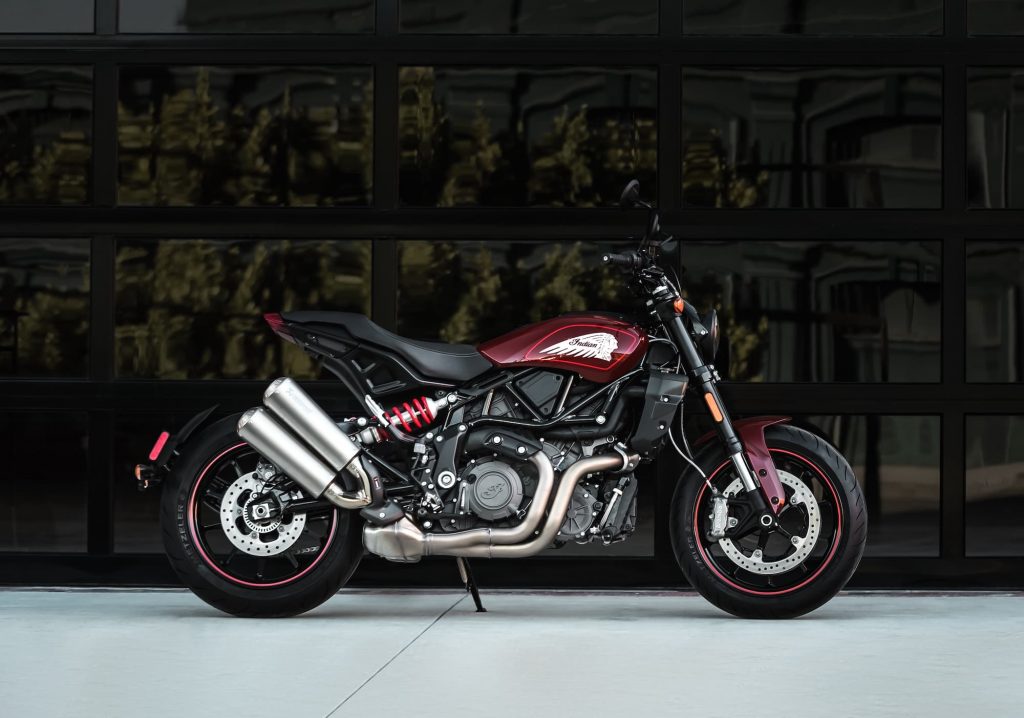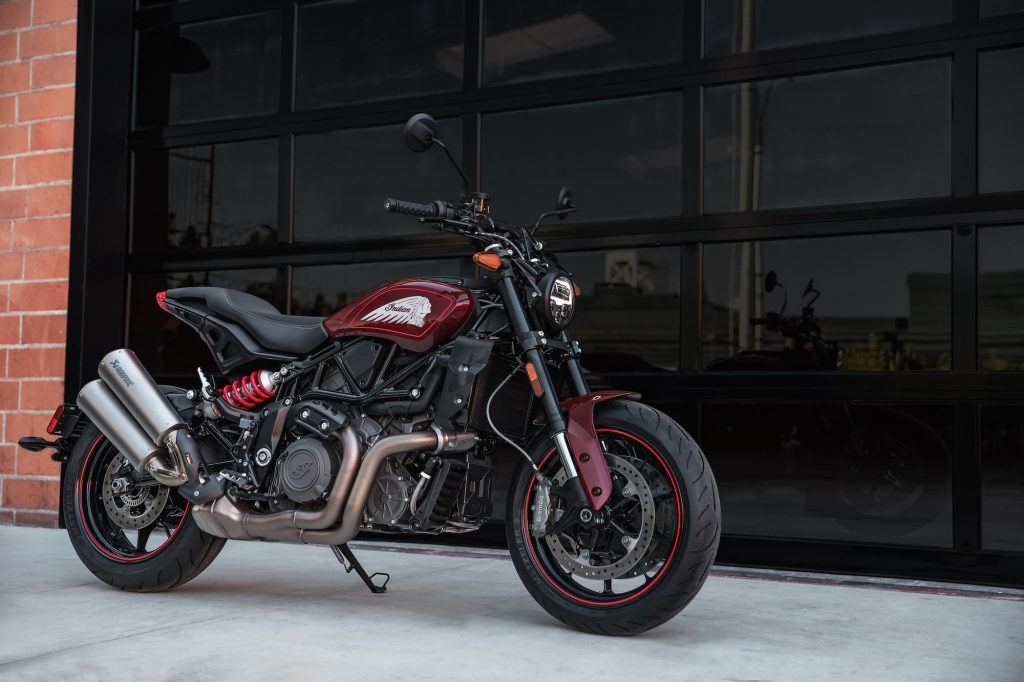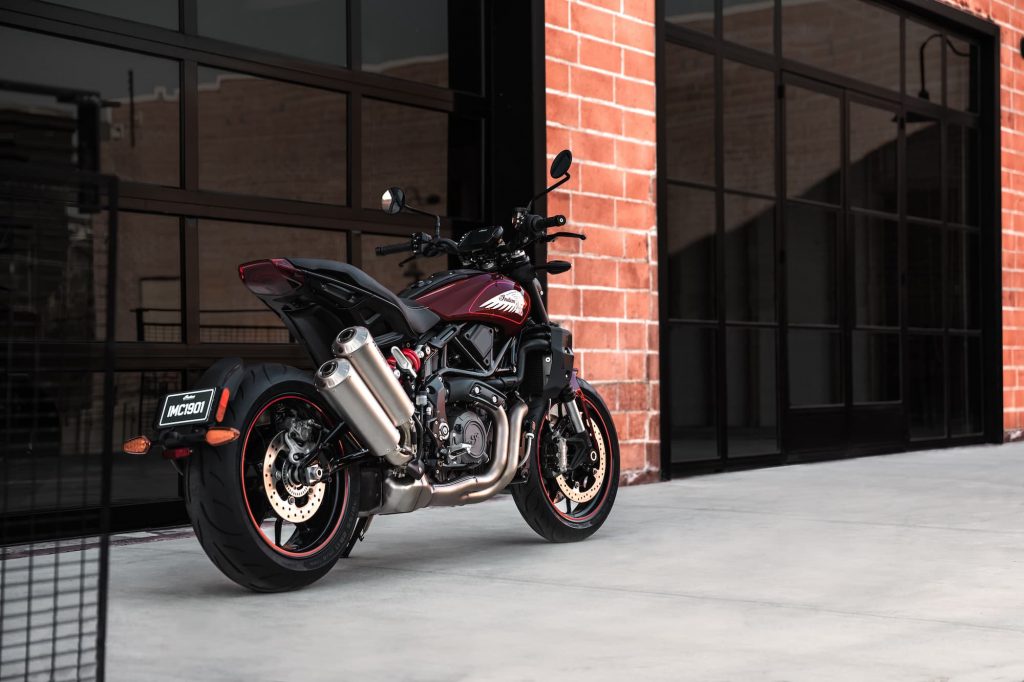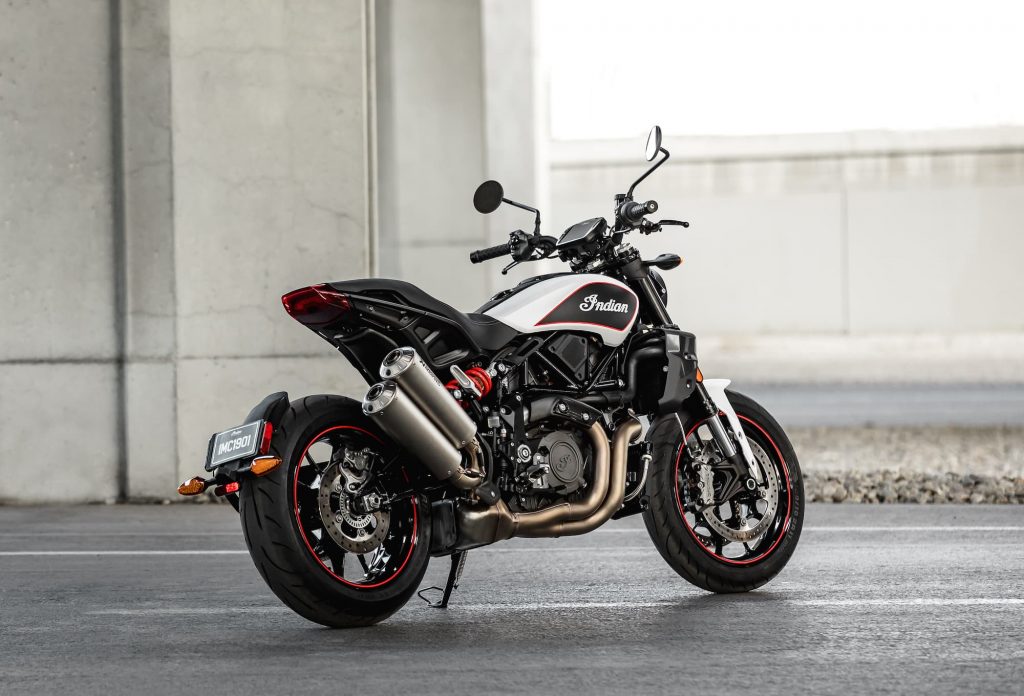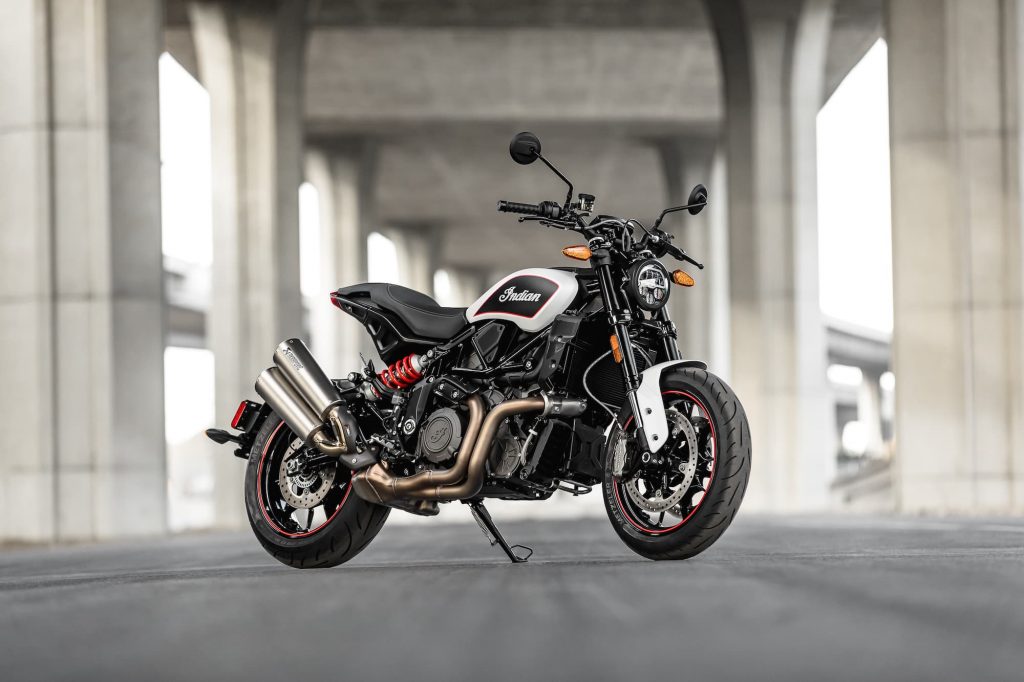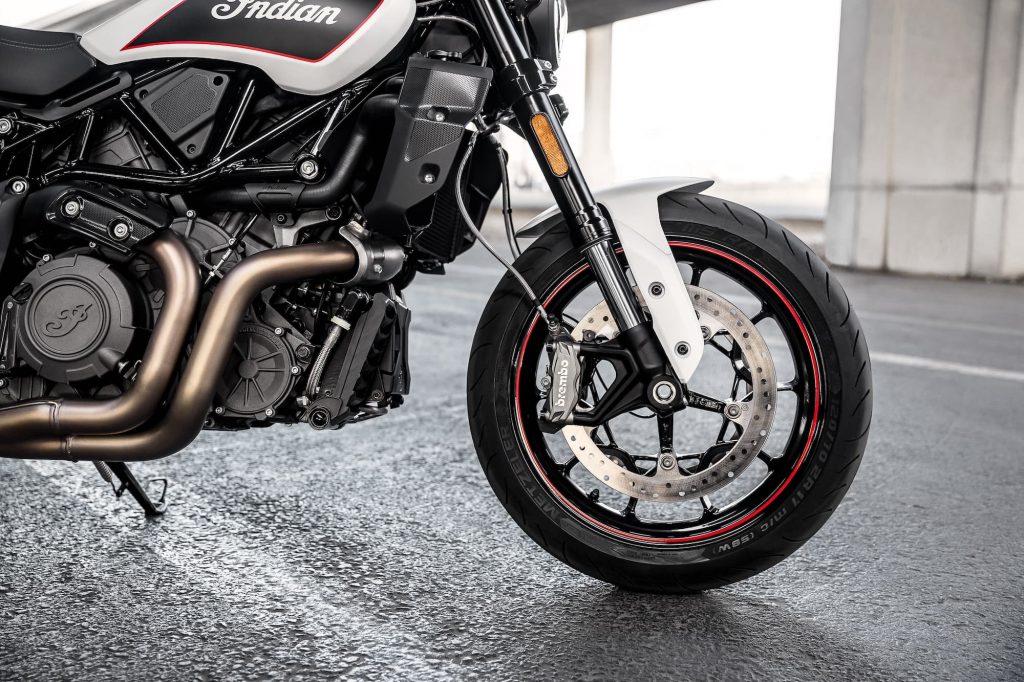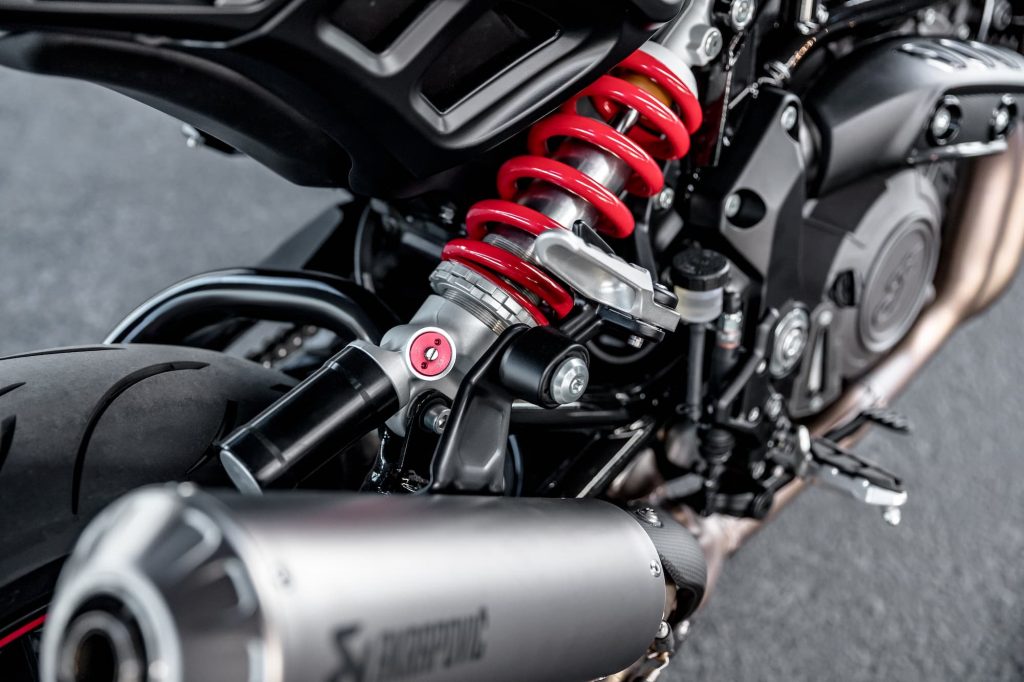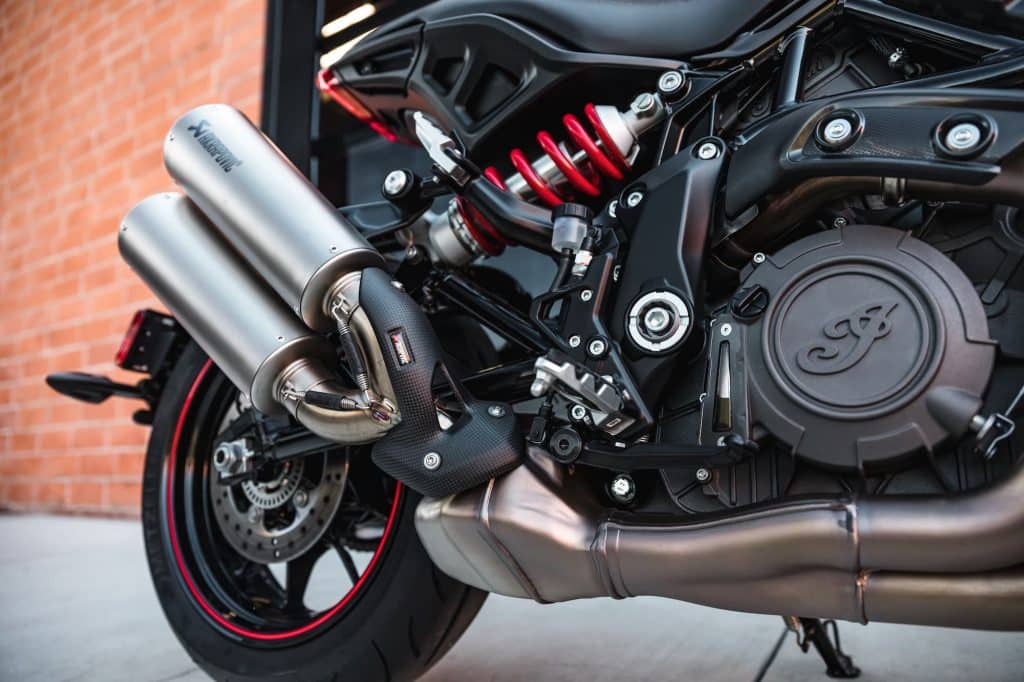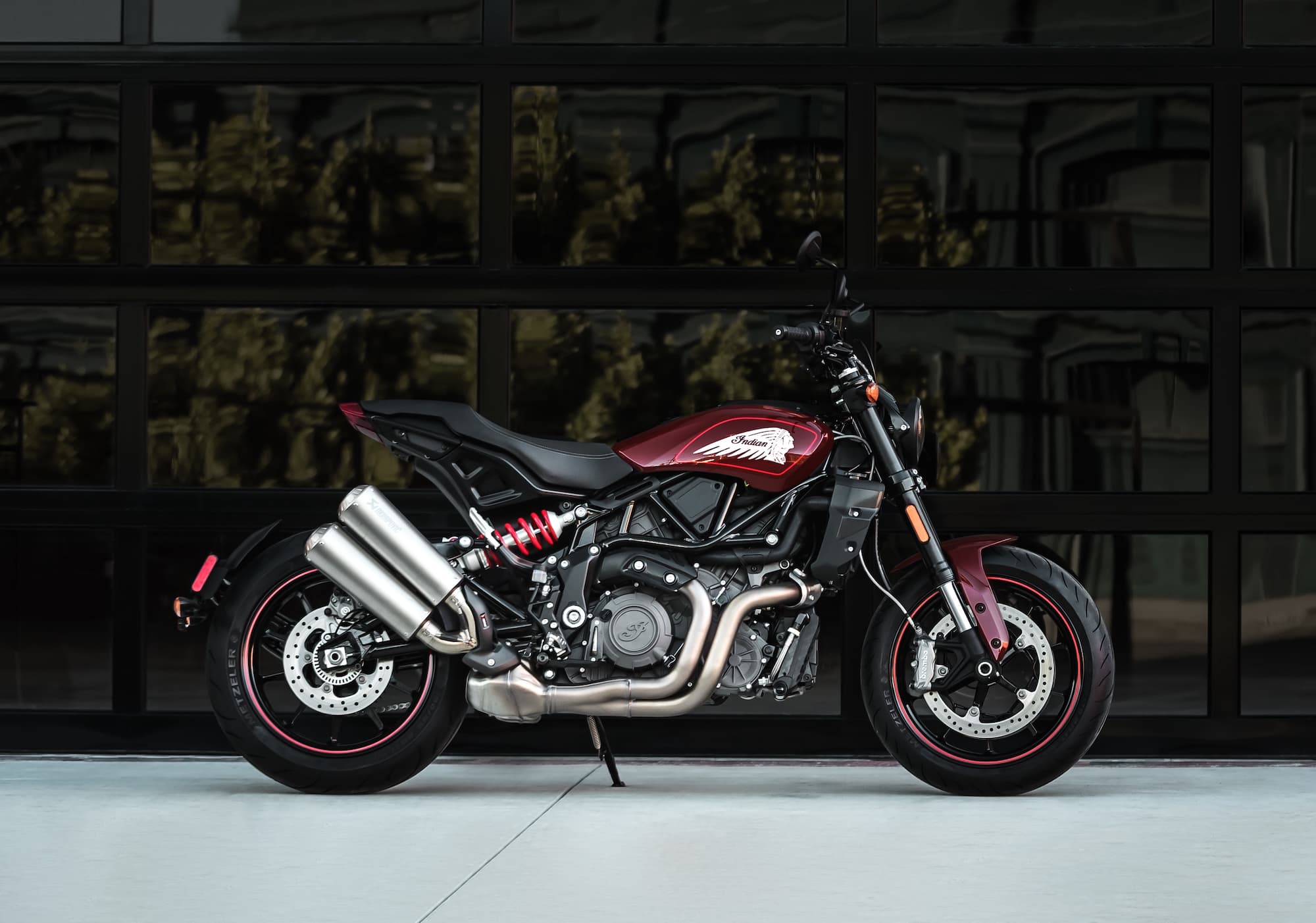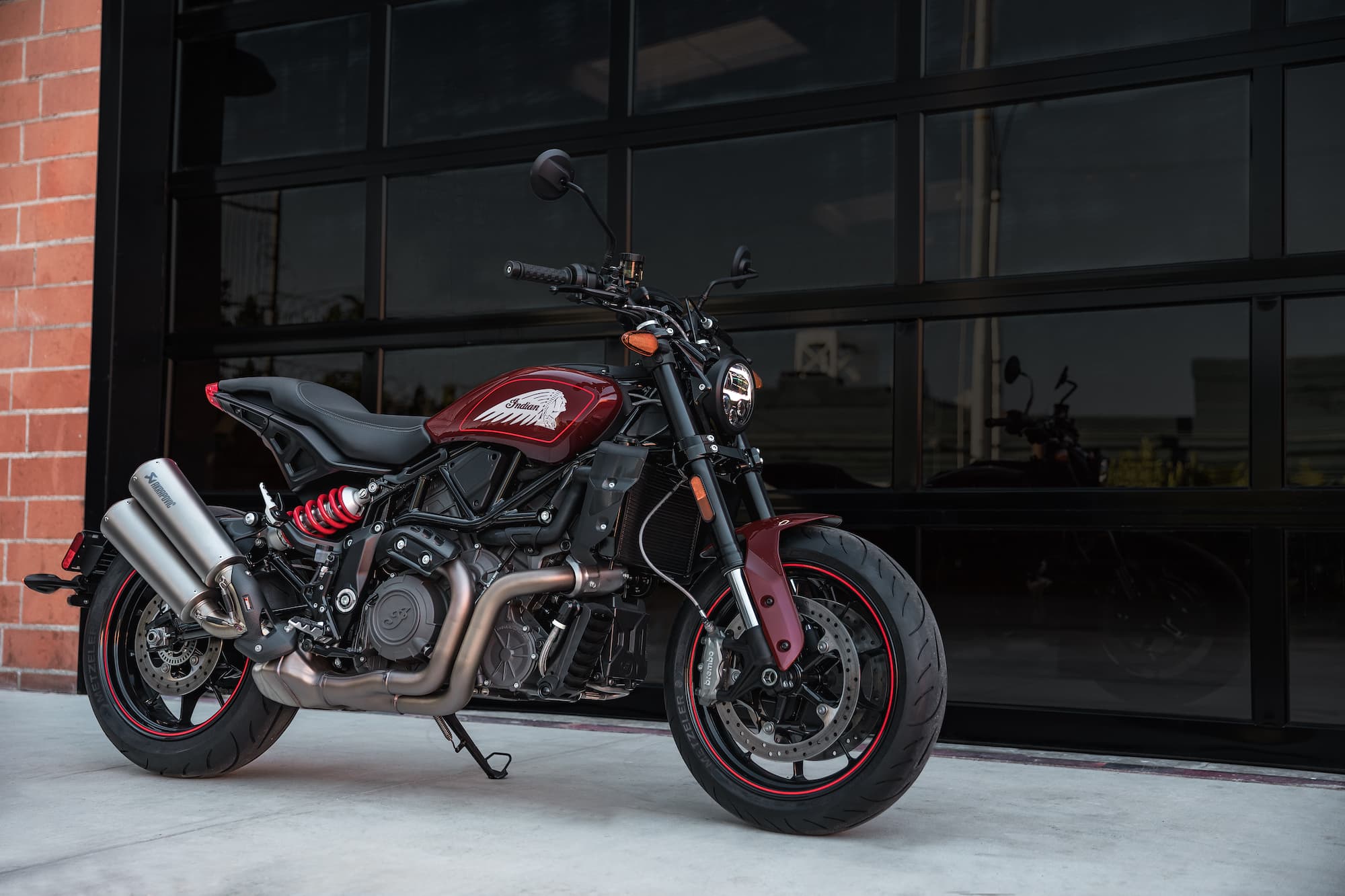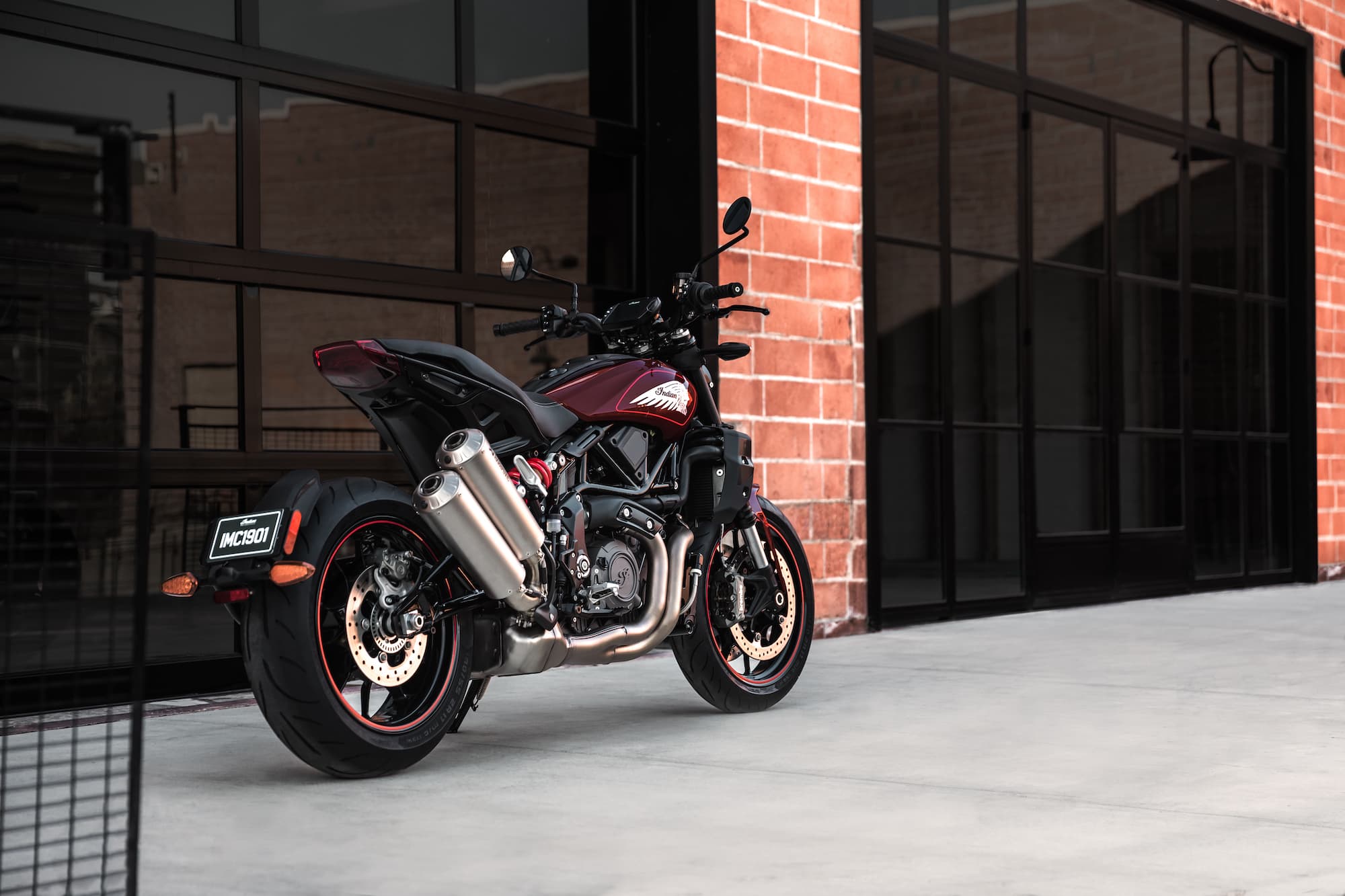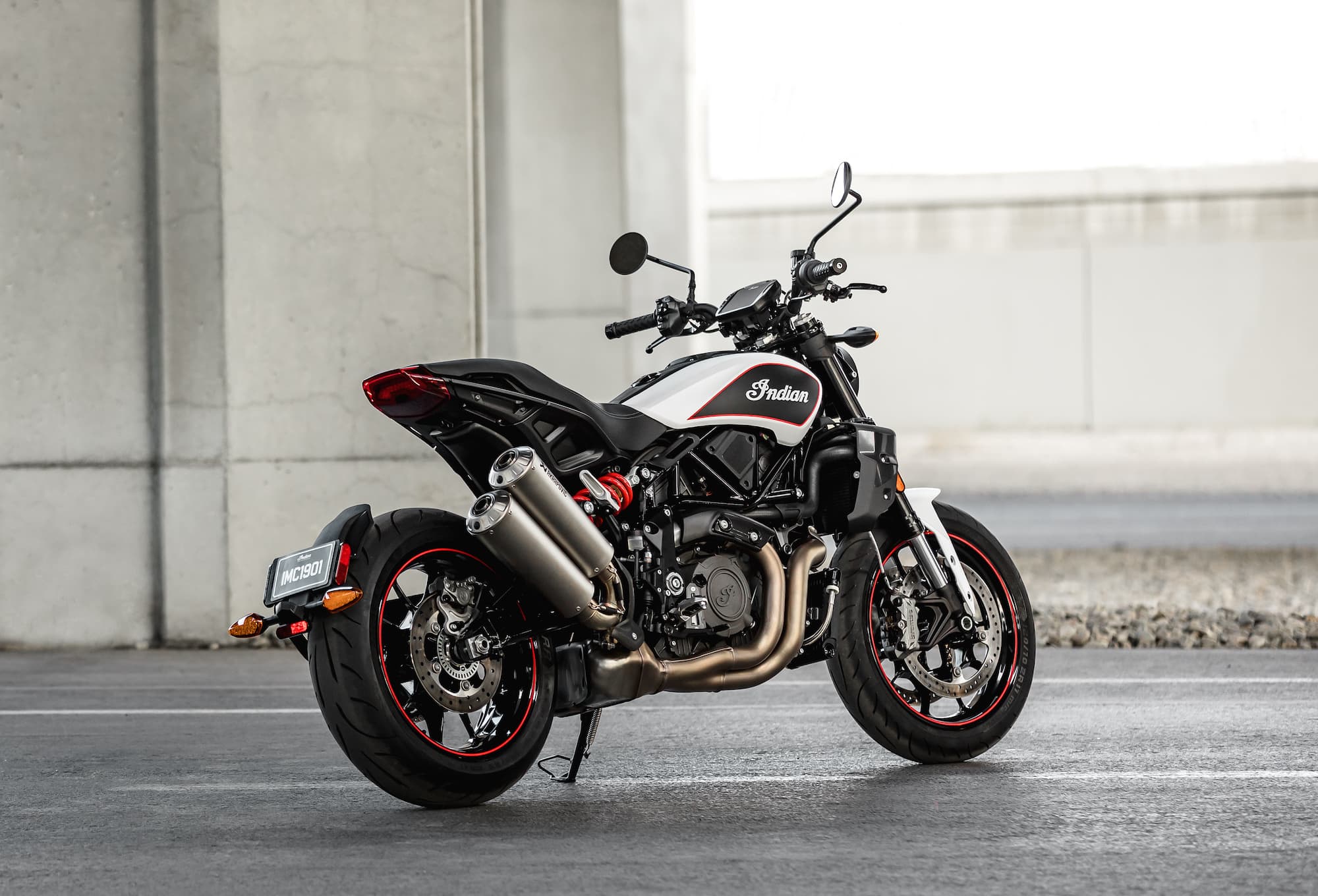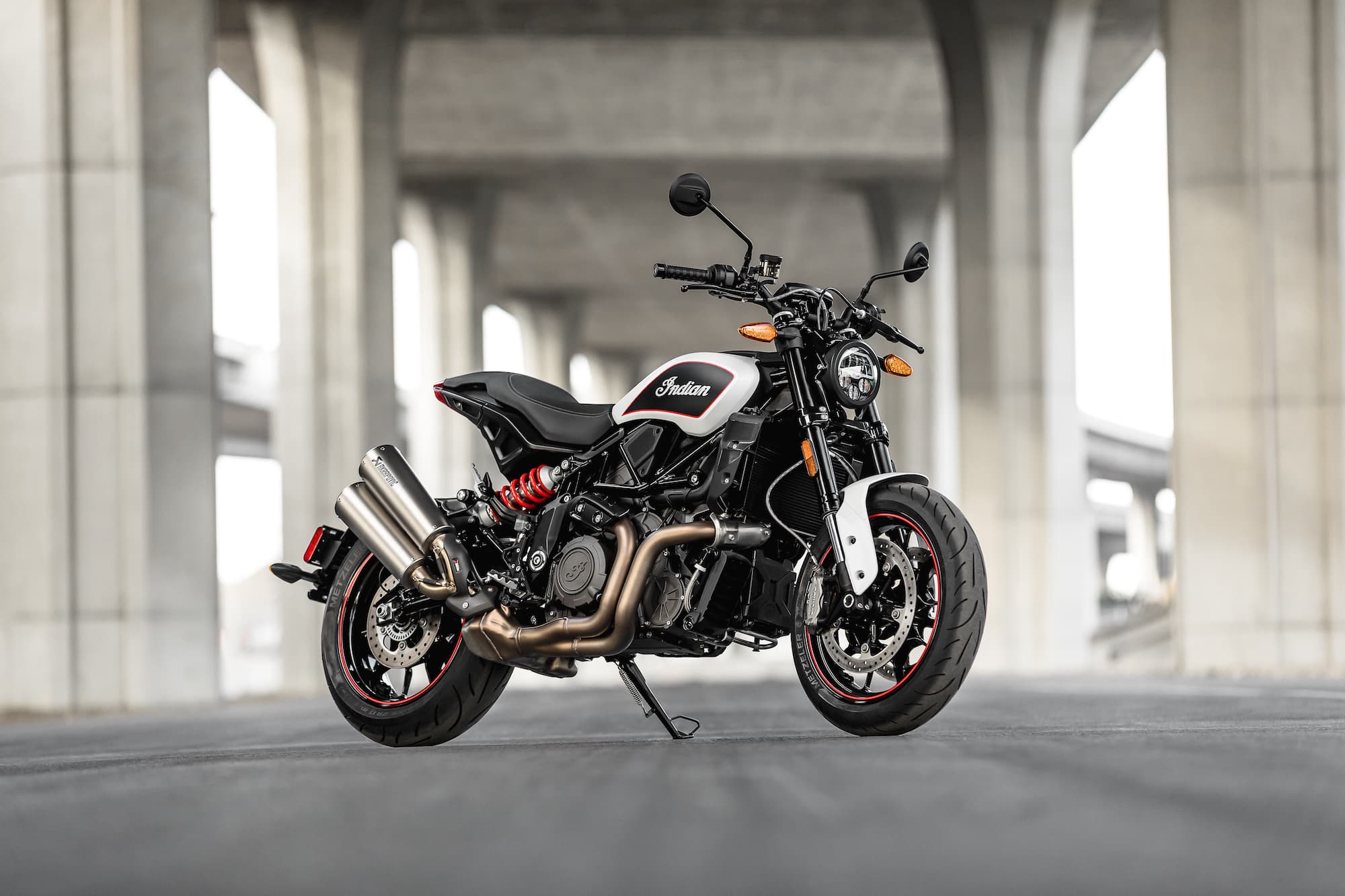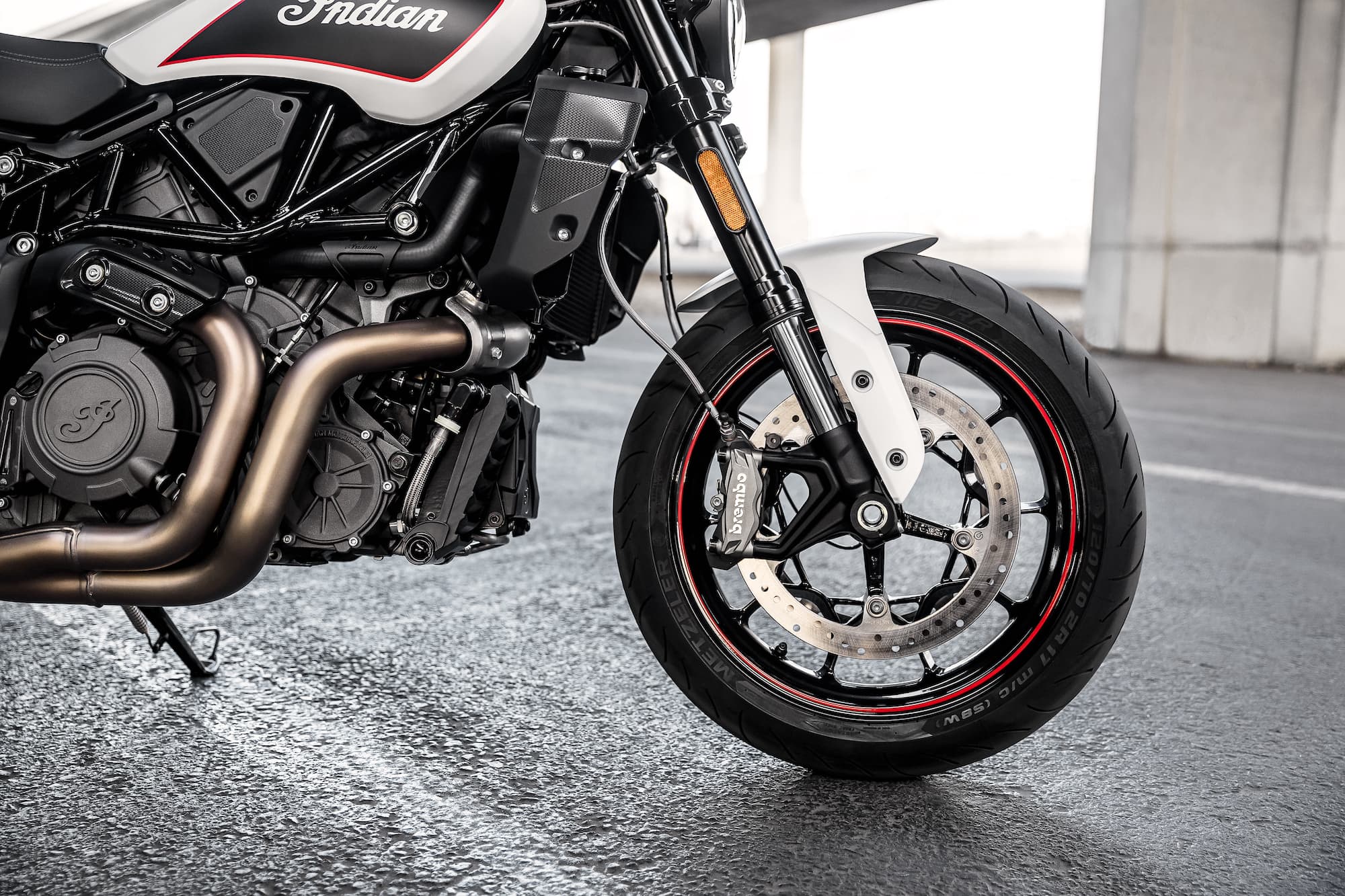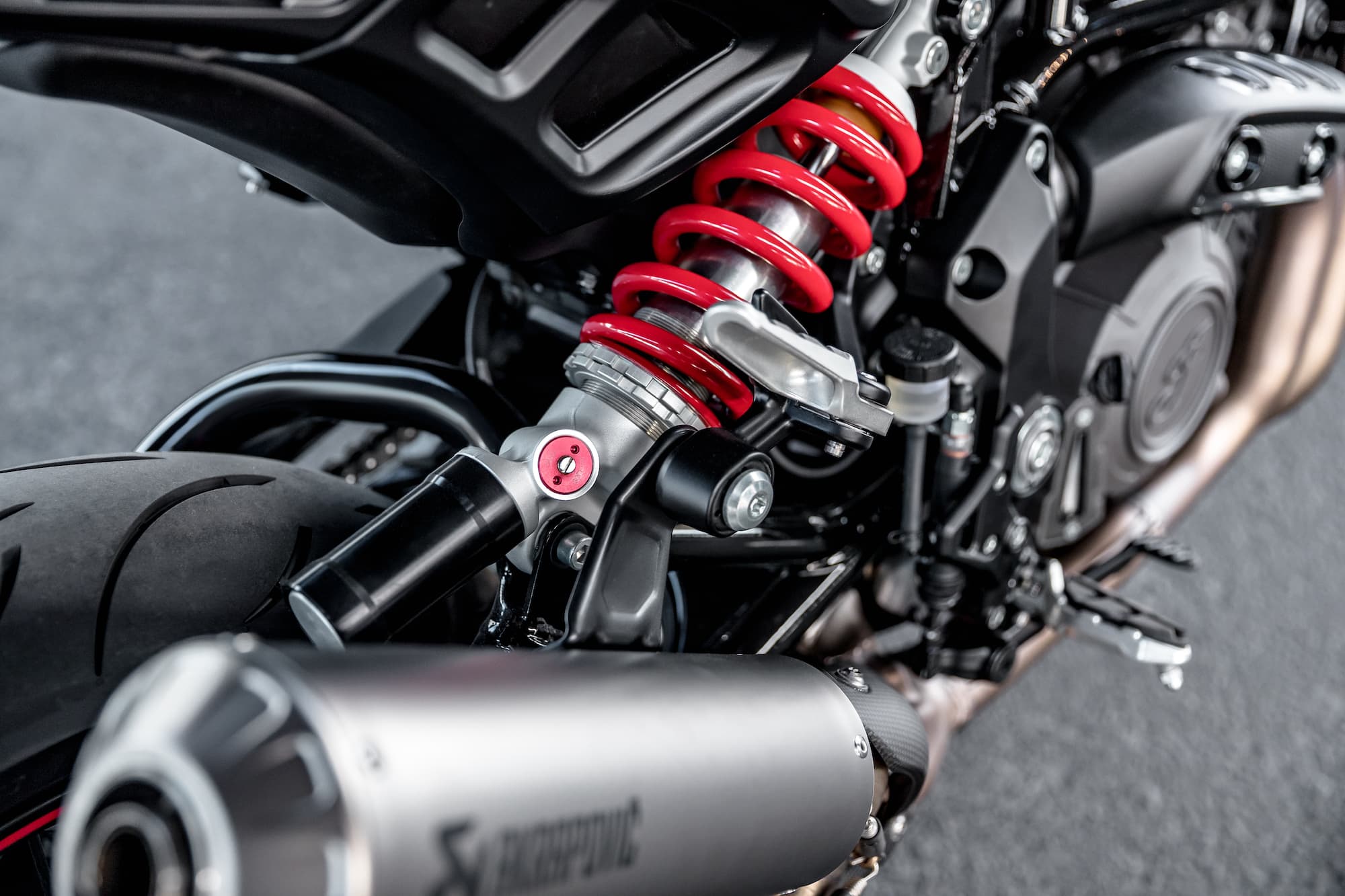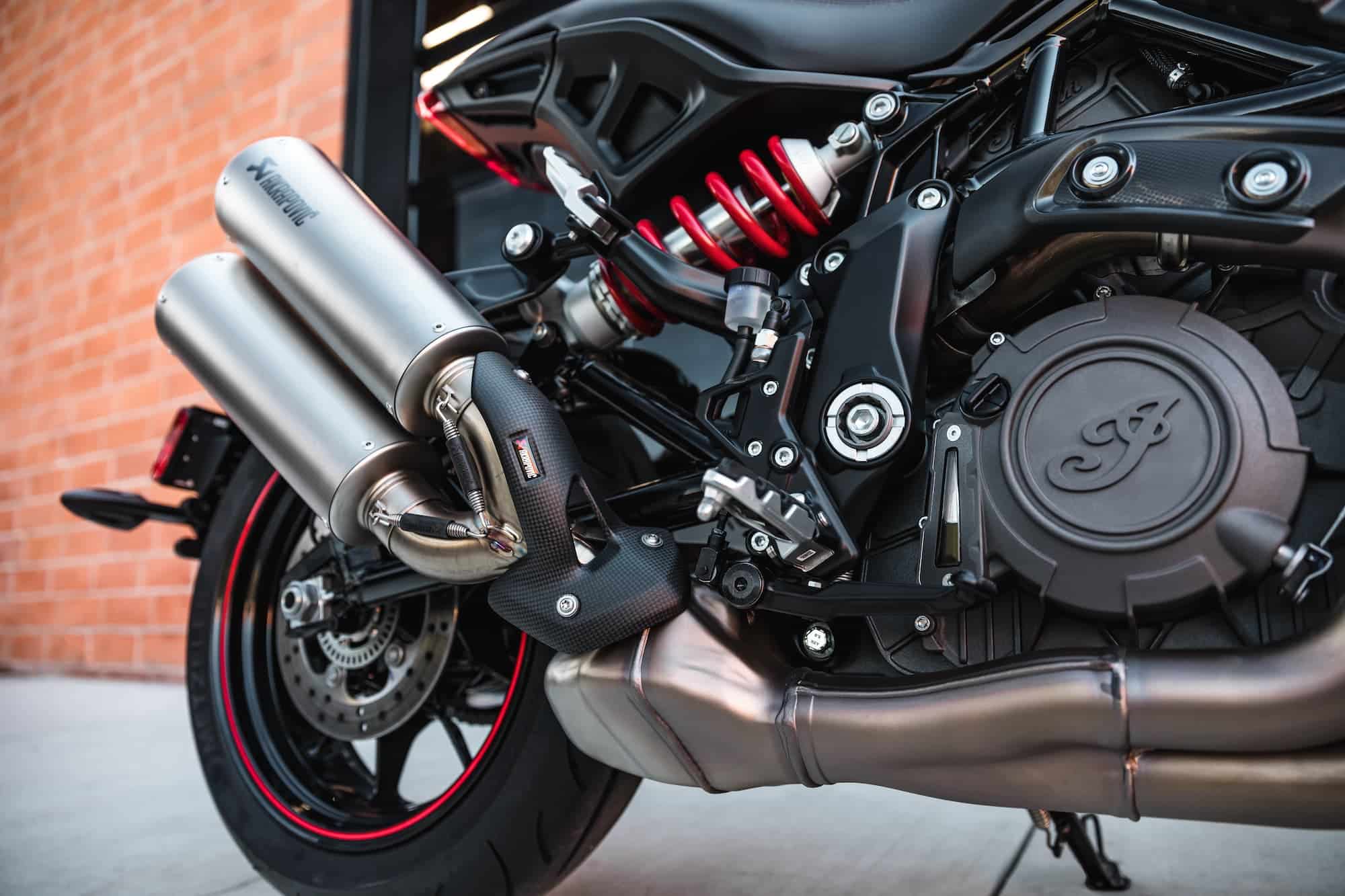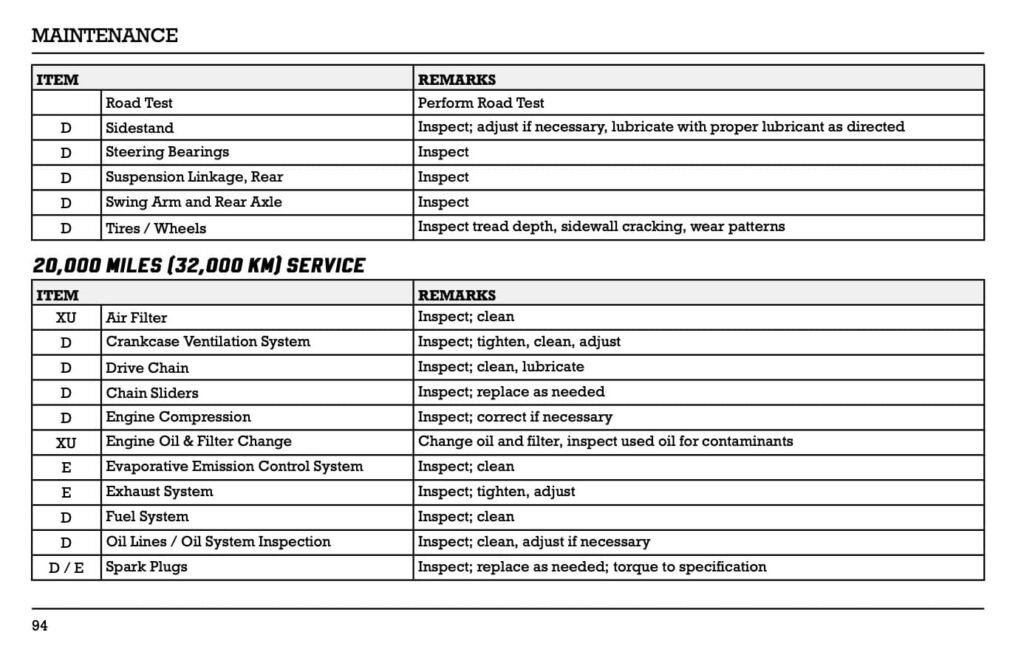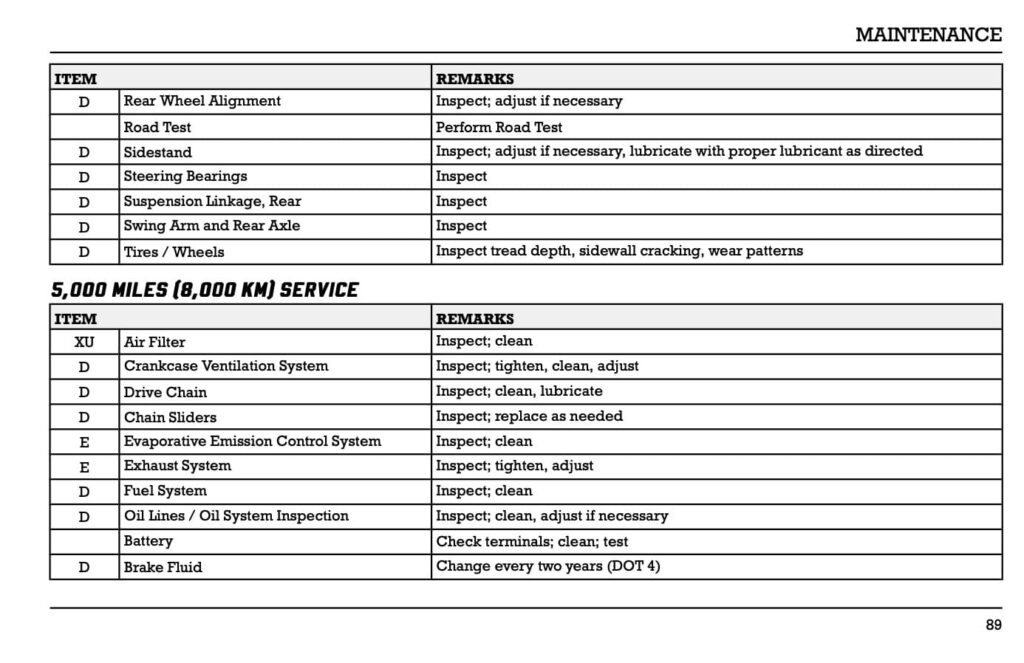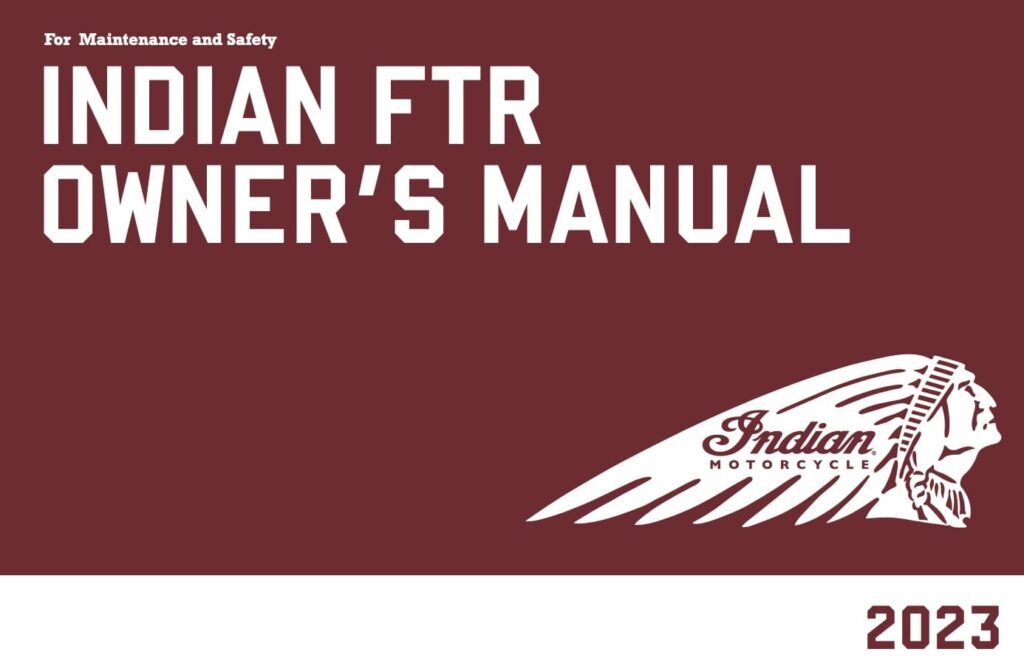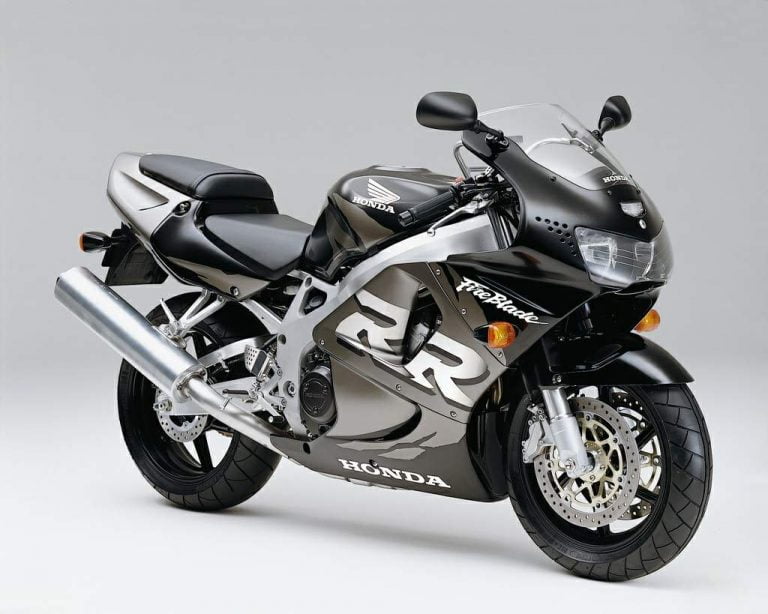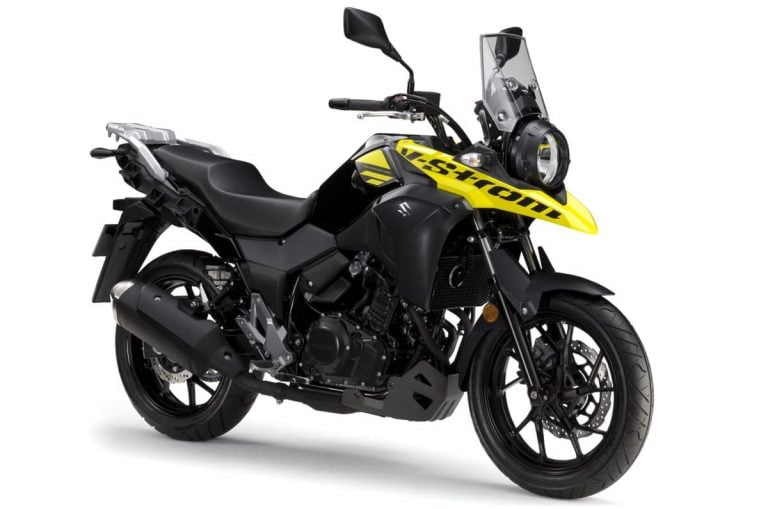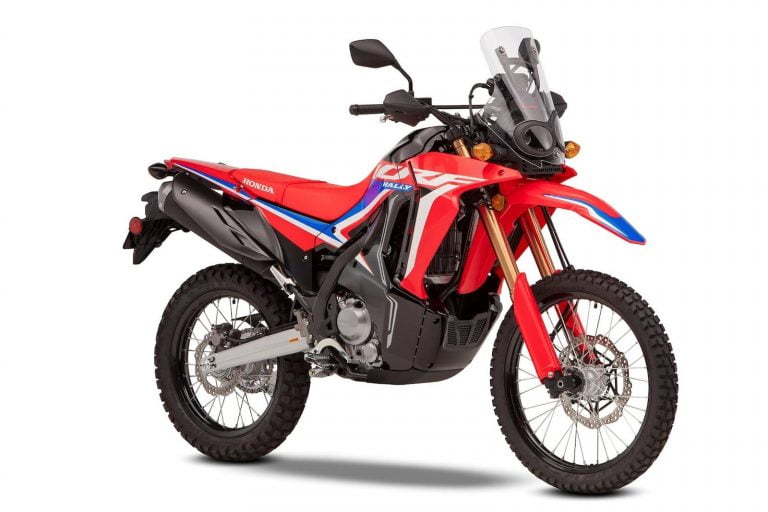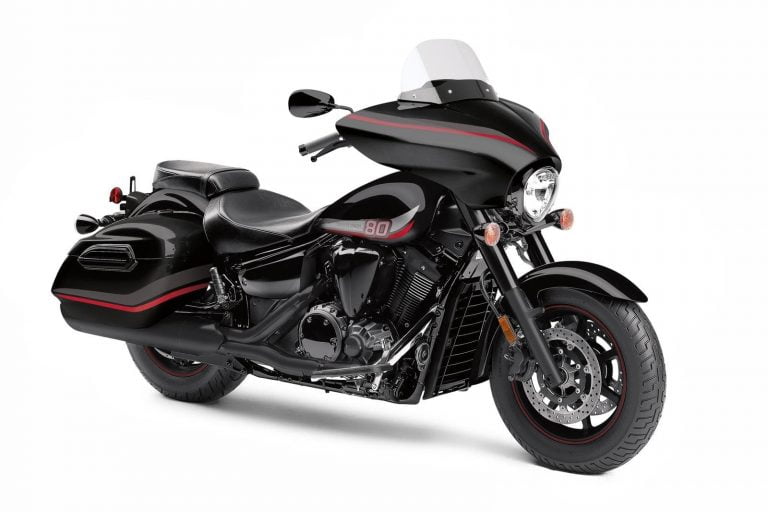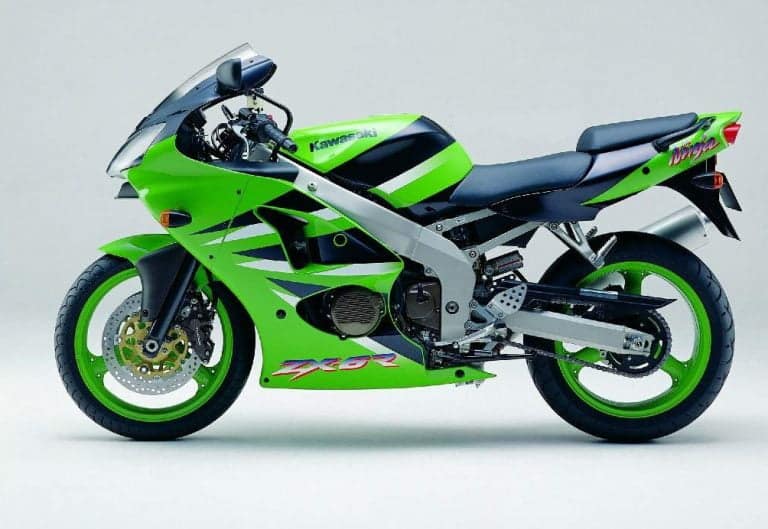Indian FTR (2021+) / S Maintenance Schedule and Service Intervals
This is the maintenance schedule and service intervals for the Indian FTR, released for the 2021/2022 model years (depending on market). The schedule and info below came from a mix of the owner’s manual, internet forums, and parts catalogues.
This maintenance schedule is also applicable to the FTR S, FTR R Carbon, and other high-spec variants. They share the same engine and basic platform (though with different electronics, suspension, and wheels — mentioned below), so the maintenance schedule is the same.
The Indian FTR continues the legacy of the 2019 Indian FTR 1200 and FTR 1200 S, but has dropped the “1200” part of the name. The Indian FTR is still based on a 1203cc liquid-cooled V-twin engine that makes peak power of 92 kW (123 bhp) at around 8000 rpm (various sources differ slightly on the rpm point), and peak torque of 120 Nm (89 ft-lb) at 6000 rpm.
The V-twin engine is thoroughly modern, with twin cams and four valves per cylinder. The drive train is via a six-speed gearbox and chain. This is a modern upright sport bike!
This site has links for things like oil and spark plugs from which we earn a commission (which unfortunately nobody can save, not even us). If you appreciate this work, then please use those links. Thanks!
Indian FTR Service Intervals Overview
Overall, the Indian FTR has 5000 mile / 8000 km service intervals. But you only need to change the oil and filter every 10000 miles / 16000 km.
The valve inspection is every 20000 miles or 32000 km, which is fairly middle ground for middleweight liquid-cooled bikes. The FTR has dual overhead camshafts with “bucket”-style shims under the camshafts. The job is doable by a home mechanic.
The FTR’s engine is liquid-cooled, which means you do need to check the coolant level and periodically change it. You also need to change the brake fluid every two years — and Indian gives it a distance interval, too.
Finally, since the Indian FTR has a chain drive, you need to check the slack and adjust it. Details on this procedure are below.
What you need to service your Indian FTR
Servicing your Indian FTR may seem intimidating if it’s your first bike, though it’d be quite an awesome first bike and I can imagine you’d want to take care of it.
You should regularly change the oil and filter, and check and adjust the belt tension at a minimum.
| Part | Indian FTR spec |
|---|---|
| Engine Oil | Indian recommends “Indian Motorcycle Synthetic Blend 15W-60” engine oil. This is an oil that meets API SM and ILSAC GF-4, and JASO MA specifications and that’s 15W-60 in weight. Indian recommends using the Indian Motorcycle Oil Change Kit. |
| Oil filter | Change the oil filter every time you change the oil. An oil filter is included with the oil change kit, or you can separately get a Hiflofiltro part number HF198. |
| Coolant | Indian recommends a 50/50 anti-freeze (ethylene glycol) premix. Many fit the bill. Check Revzilla’s coolant selection. |
| Chain lube | Make sure you keep your chain maintained — a Motul chain care kit is a popular option. |
| Air filter | You need to change the air filter every 10,000 miles (16,000 km). The part number is 7082325. You can also use K&N air filter PL-1219. |
| Spark plugs | Change spark plugs periodically with an NGK MR7F with an 0.030 inch (0.80 mm) gap (you might need a spark plug gapping tool) |
| Battery | Dead battery? Replace it with a Yuasa YTX14H (the OEM battery). |
Maintenance Schedule for the Indian FTR
This is the maintenance schedule for the Indian FTR, reformatted to make it easier to read, with items in a more intuitive order (not just alphabetical… why would “Road Test” be anywhere but at the end, for example).
The maintenance checklists are listed as individual lists for each mileage point. But there’s no overview. So below is a simplified view, broken into
- The “major items” maintenance schedule (e.g. oil changes, valve clearance), and
- The “inspection checklist” of things to look over.
Major notes about the Indian FTR’s maintenance schedule
- Most items have a distance interval only. E.g. Indian doesn’t require an annual oil change if you hven’t done mileage.
- There’s no maintenance interval for the coolant in the schedule lists, but Indian recommends replacing it every 5 years or 50,000 miles / 80,000 km. The FTR has a liquid-cooled engine. Most maintenance schedules recommend frequently checking the coolant level or replacing the coolant every 2-4 years.
Major Items Maintenance Schedule
This is the “major items” maintenance schedule
- Follow the earlier of distance-based or time-based service intervals.
- Torque specs are mentioned inline, as are some replacement parts.
| mi x 1000 | 0.5 | 2.5 | 5 | 10 | 15 | 20 | |
|---|---|---|---|---|---|---|---|
| km x 1000 | 0.8 | 4 | 8 | 16 | 24 | 32 | Every |
| Inspection checklist — Perform all items (see below) | ✓ | ✓ | ✓ | ✓ | ✓ | ✓ | |
| Air Filter — Inspect; clean | ✓ | ✓ | ✓ | ✓ | |||
| Air Filter — Replace | ✓ | ||||||
| Drive Chain — Replace | ✓ | ||||||
| Chain Sliders — Inspect; replace as needed | ✓ | ✓ | ✓ | ||||
| Engine Compression — Inspect; correct if necessary | ✓ | ✓ | |||||
| Engine Mount Fasteners — Inspect; tighten, adjust | ✓ | 50000 miles / 80000 km | |||||
| Engine Oil & Filter Change — Change oil and filter, inspect used oil for contaminants Oil drain plug torque: 20 Nm / 15 lb-ft Oil filter torque: 13 Nm / 10 lb-ft, or about 3/4 to 1 full turn after seal contacts | ✓ | ✓ | ✓ | ||||
| Spark Plugs — Inspect; replace as needed; torque 10 Nm / 7.5 lb-ft | ✓ | ✓ | |||||
| Spark plugs — Replace, torque 10 Nm / 7.5 lb-ft | 30000 miles / 48000 km | ||||||
| Valve Lash Clearance — Inspect; adjust if necessary | ✓ | ||||||
| Brake Fluid — Inspect Level | ✓ | ✓ | ✓ | ✓ | |||
| Brake Fluid — Replace | ✓ | ✓ | 2 years | ||||
| Front Fork Oil — Inspect | ✓ | ✓ | ✓ | ✓ | |||
| Front Fork Oil — Replace | ✓ | 2 years | |||||
| Head Light — Inspect; adjust if necessary Headlight adjustment fastener torque: 34 Nm / 25 lb-ft | ✓ | ✓ | ✓ | ✓ | |||
| Rear shock absorber — Replace | 50,000 miles (80,000 km) | ||||||
| Coolant — Replace | 50,000 miles (80,000 km) or 5 years |
Inspection Checklist
Below is the standard inspection checklist for the FTR.
A couple of these items came from the recommended daily checks (that weren’t also in the maintenance schedule).
| Indian FTR / FTR S Inspection Checklist |
|---|
| Drive Chain — Inspect; clean, lubricate |
| Fuel System — Inspect; clean |
| Oil Lines / Oil System Inspection — Inspect; clean, adjust if necessary |
| Coolant — Check level Replace at 50,000 miles / 80,000 km or 5 years |
| Battery — Check terminals; clean Battery terminal fasteners: 3 Nm / 25 lb-in Battery cover fasteners: 4 Nm / 36 lb-in |
| Brake Pads — Inspect pad wear; replace if worn beyond service limit |
| Clutch Lever — Lubricate with proper lubricant as directed |
| Clutch Cable Freeplay — Inspect; adjust if necessary |
| Control Cable Ends — Inspect; lubricate with proper lubricant as directed |
| Fasteners — Inspect; tighten if necessary |
| Front Brake Lever — Adjust if necessary, lubricate with proper lubricant as directed |
| Front Forks and Front Axle — Inspect; adjust if necessary Front axle torque: 75 Nm / 55 lb-ft Axle pinch bolt torque: 19 Nm / 14 lb-ft |
| Gear Shift Pedal — Inspect; lubricate, adjust if necessary |
| Rear Brake Pedal — Inspect; lubricate, adjust if necessary |
| Driver and Passenger Pegs — Inspect; lubricate if necessary |
| Rear Shock Absorber — Inspect; adjust if necessary Replace at 50,000 miles / 80,000 km |
| Rear Wheel Alignment — Inspect; adjust if necessary |
| Sidestand — Lubricate with proper lubricant as directed |
| Steering Bearings — Inspect |
| Suspension Linkage, Rear — Inspect |
| Swing Arm and Rear Axle — Inspect |
| Tires / Wheels — Inspect tread depth, sidewall cracking, wear patterns |
| Crankcase Ventilation System — Inspect; tighten, clean, adjust |
| Evaporative Emission Control System — Inspect; clean |
| Exhaust System — Inspect; tighten, adjust |
| Road Test — Perform Road Test |
Indian FTR Chain Maintenance
Like on any chain-driven motorcycle, you have to regularly maintain the chain on the Indian FTR.
Before rides, check chain and sprocket condition, cleanliness, lubrication condition, and slack (sag). In terms of wear, look for cracks, missing teeth, or shark toothingo n the teeth.
If it needs cleaning and lubrication, use a chain brush and chain cleaning kit (e.g. the Motul chain cleaning kit, though Indian recommends Indian chain lube) to clean and lube it.
After rides, particularly in the rain, do the same thing.
If the chain or sprockets are being replaced due to damage, replace them all as a set if the drive system has more than 5000 miles (8000 km) of use.
Checking Chain Slack
To check the slack on the Indian FTR, put the bike in neutral, onto its kickstand, and on a level surface.
Use a chain tension gauge to push upward on the chain with 10 lb (4.5 kg) of force. The chain slack is defined as the distance between the bottom of the swing arm, behind the chain slider, to the top of the chain.
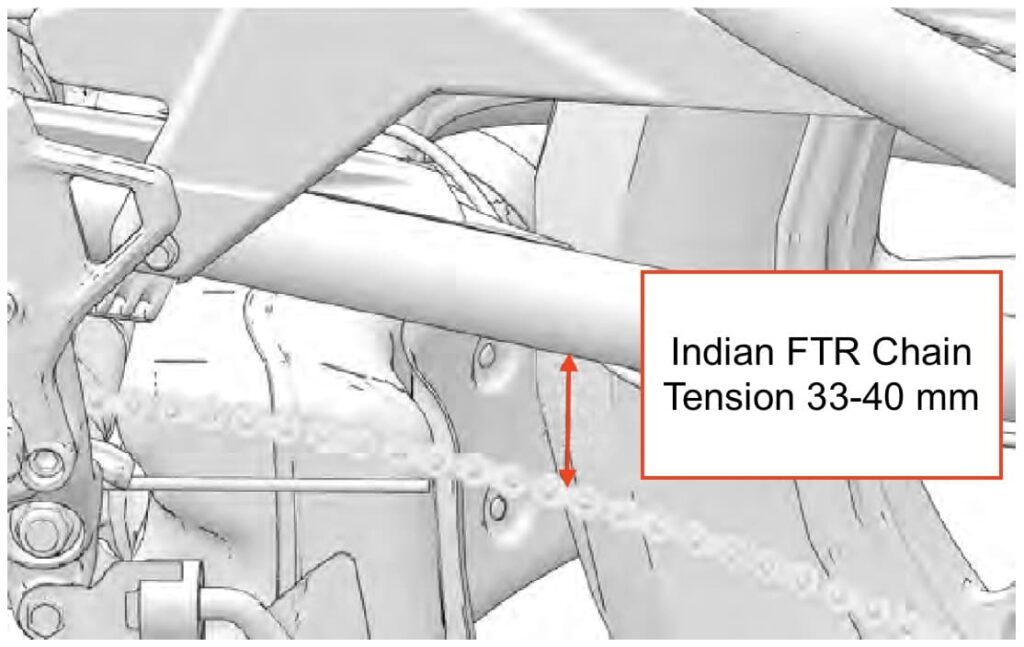
Target chain slack for the Indian FTR: 33-40 mm (1 5/16- 1 19/32 inches)
If the chain slack is out of spec, you need to adjust it.
Adjusting chain slack
To adjust the chain slack on the Indian FTR, follow the steps below. As with measuring chain slack, make sure that the motorcycle is on a level surface on its kickstand, in neutral, with no weight on it (no saddlebags / luggage).
First, check chain stretch. Hang a 20-25 lb (9-11 kg) weight on the chain. On the top stretch of the chain, measure the distance of 20 lengths (e.g. from pin 1 to pin 21). If it’s more than 319 mm, the chain is too worn, and you should replace it.
If the chain isn’t too worn, follow the steps below.
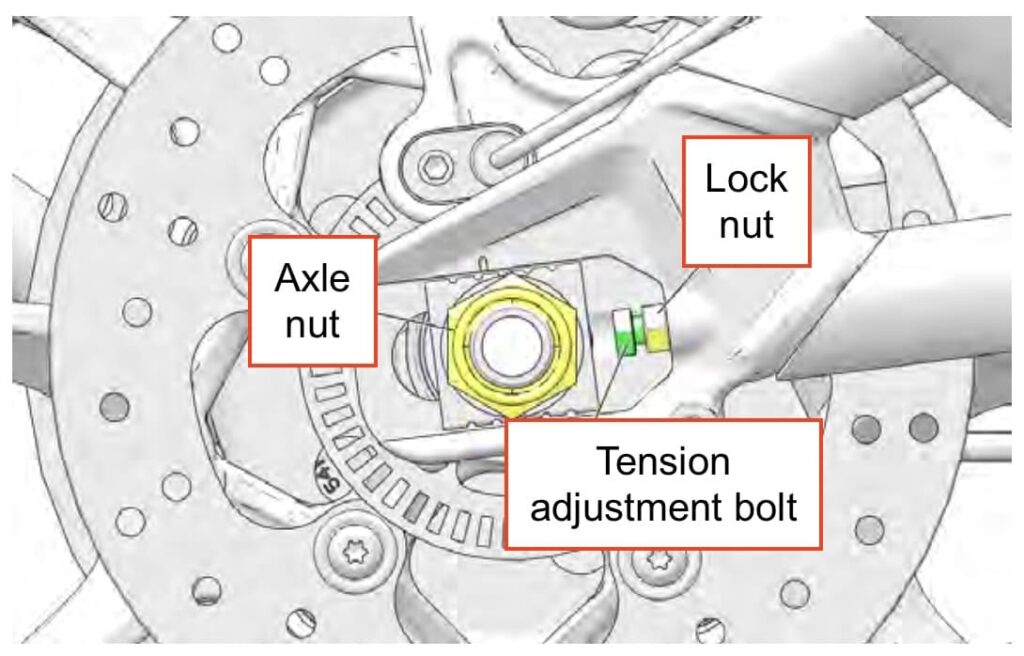
- Loosen the rear axle and the lock nuts on either side of the axle.
- Turn the tension adjustment bolts to tighten (or loosen) the chain. Keep checking the chain tension to see if it has come within spec.
- Keep an eye on the adjuster alignment marks on either side of the axle. Make sure that the adjustment is to the same point.
- When you’re done, tighten the lock nuts to 16 Nm (12 lb-ft), and the axle nut to 125 Nm ( 92 lb-ft).
- Re-check the chain slack again to make sure it’s still within spec.
Tyre sizes and pressures
The earlier FTR had a different-sized tire than the 2021+ Indian FTR (and other variants), which ships with 17-inch tires front and rear. This isn’t a flat tracker; it’s a road bike!
The FTR Sport and FTR R Carbon ship with Metzeler Sportec M9 RR tires.
| Wheel | Tyre size | Tyre pressure (cold) |
|---|---|---|
| Front | 120/780 ZR 17 58W | 36 psi / 248 kPa / 2.48 bar |
| Rear | 180/55 ZR 17 73W | 40 psi (276 kPa / 2.76 bar) |
The FTR Rally ships with Pirelly Scorpion Rally STR tires, and the size is slightly different — 19/18 like the previous gen.
| Wheel | Tyre size | Tyre pressure (cold) |
|---|---|---|
| Front | 120/780 R 19 60V | 36 psi / 248 kPa / 2.48 bar |
| Rear | 150/70 R 18 70V | 40 psi (276 kPa / 2.76 bar) |
Of course, recommended tyre pressures are often to minimise tyre wear and associated expense, so find the ideal pressure for your weight and ride style.
From 2022 onward, the Indian FTR ships with 17 inch tyres front and rear, more committing to the “road/sports bike” demo.
About the Indian FTR (2021+)
The Indian FTR continues the same vein of motorcycle as the original FTR 1200, but with a few enhancements for the new version — and not just a change of name.
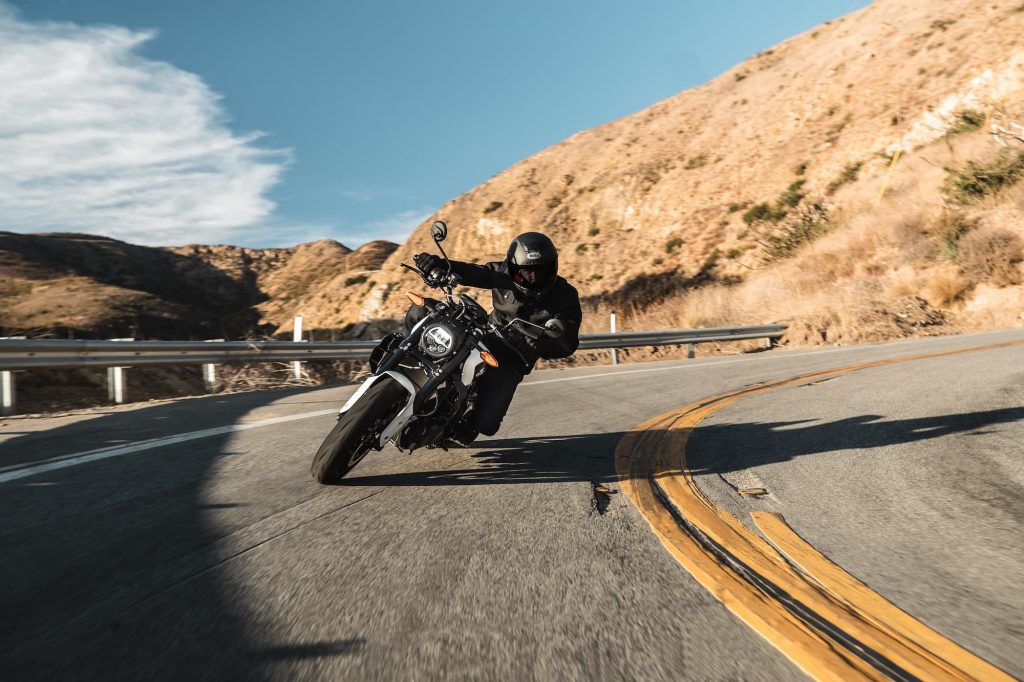
The Indian FTR is Indian’s high-performance roadster. It’s a “naked bike” with an exposed frame and engine, handlebars, and sporty but comfortable riding position.
There are very few manufacturers making sporty road-bike V twins on the market today. Ducati makes the Monster and its other Testrastretta 11 bikes, Harley-Davidson makes the RH line, and Moto Guzzi makes a couple, too. But the Japanese manufacturers are making parallel twins, triples, and fours.
Besides which, the Indian FTR is a well-liked bike on a number of fronts. It has a great amount of power, easy handling, good looks, and American cred. Harley enthusiasts have been asking for a standard bike based on the same RH model in the Sportster S for years — but Harley-Davidson hasn’t delivered yet.
The most significant change to the FTR vs the earlier FTR 1200 (aside from the mane) is 17-inch wheels front and rear. This is different from the original FTR, which had a 19-inch front and 18-inch rear, for a different aesthetic and perhaps a nod to potential off-road performance.
The larger wheels and tires (with wire spoke wheels) are still available in the FTR Rally (which was discontinued after the 2023 model year).
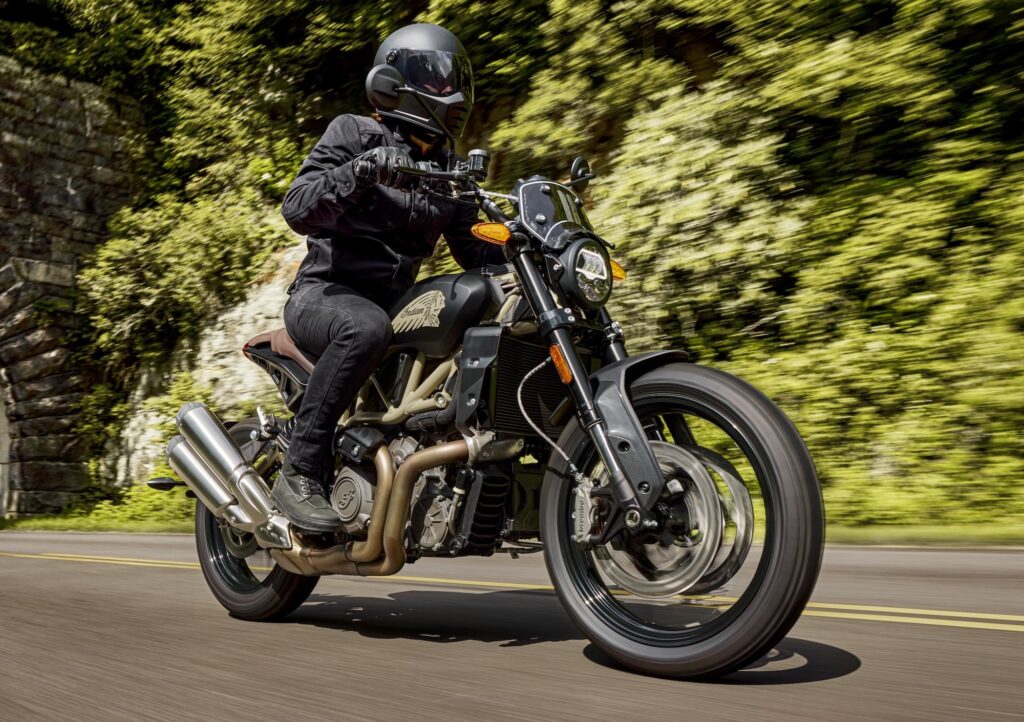
But the new 2021 Indian FTR’s wheels and tires acknowledge that the lion’s share of riders will keep the FTR on the road.
The 2021+ Indian FTR is still based on a similar platform. All the Indian FTR bikes are based on a 1203cc liquid-cooled V-twin engine that makes peak power of 90 kW (120 hp) and peak torque of 118 Nm (87 ft-lb).
Indian also enhanced the tuning of the FTR to give it better cold start performance, and to smooth out the throttle response.
Some other changes to the newer FTR vs the FTR 1200 are
- Narrower bars (some 1.5 inches narrower), for less of a “splayed out” feeling
- 1.2 inches less suspension travel — which translates to a lower ride height (1.4 inch lower, with the wheel changes) and easier flat-footing for many riders, plus less of a feeling of being perched above the bike
Indian has also stopped talking about flat track racing in the press release info of the FTR. There’s no doubt there’s an aesthetic connection, but Indian is no longer emphasising it.
The base model FTR has an analogue gauge with no electronics like phone / Bluetooth connectivity. For many people, this is actually a benefit — not everyone wants a digital dash with touch screen functionality on their motorcycle. The base model doesn’t even have a tachometer.
It also has non-adjustable suspension, a standard exhaust (a little heavier, and a little less cool sounding), and lacks the electronic ride-by-wire niceties like ride modes of the higher-spec FTR S.
The FTR has ABS, but doesn’t have the six-axis IMU of the FTR S (and other FTR models), which give them cornering ABS and other rider aids.
On to the other models… the FTR S gains a TFT display, the IMU (which helps it with traction, stability, and wheelie control), though no suspension improvements. Both the FTR and FTR S have fully adjustable Sachs suspension.
The FTR Carbon has all that the S has but also Öhlins suspension front and rear.
But even the base model Indian FTR is still not a bike to be trifled with. The suspension is well-tuned for general street use for people of average weight. It just might not be the best option if you intend to race your FTR, or if you are someone who would benefit from significantly adjusting the suspension parameters.
Reference — Screenshots from the Manual for the Indian FTR
The above maintenance schedule was adapted from the manual for the Indian FTR (2021).
The FTR’s maintenance schedule is presented in to-do lists at every interval, and is thus very long. This is different from how Indian presents maintenance schedules for other motorcycles, e.g. the Indian Scout 1250.
You can get the original manual for the FTR from Indian’s website here.
